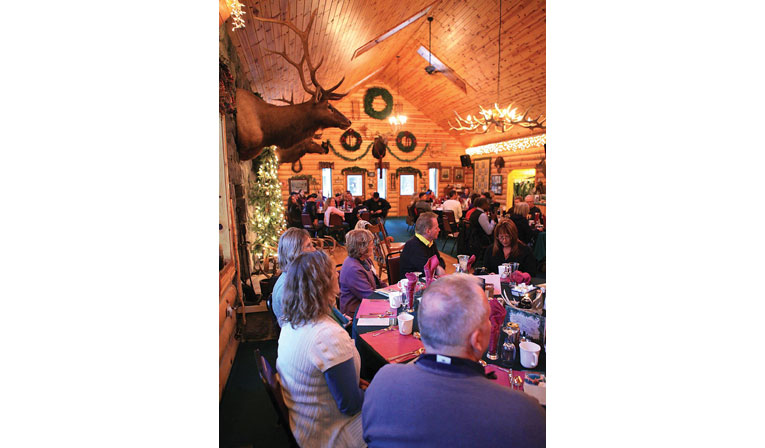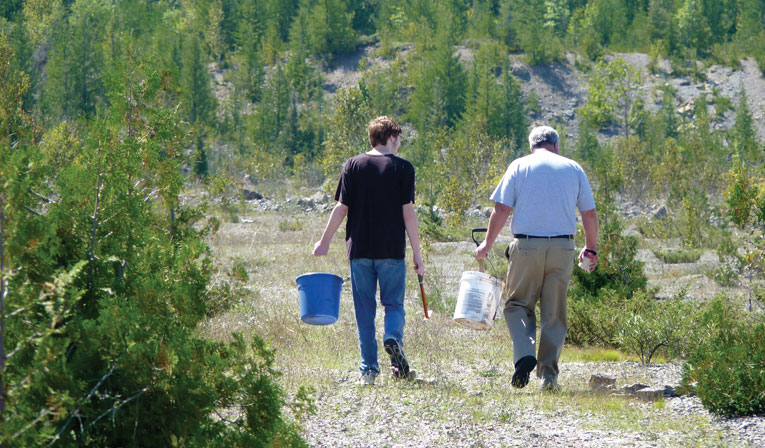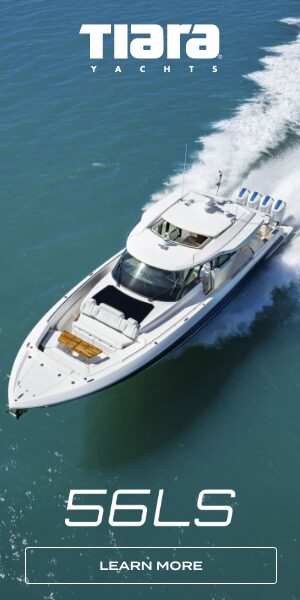Photo by Tane Casserley/NOAA
Woods and water. Fossils and fishing. Sinkholes and stars. Alpena, Michigan’s natural attributes initially shaped its history as a Lake Huron fishing port and lumbering center. After the forests were depleted, limestone for cement production helped the city continue to thrive. Located on Thunder Bay, a natural harbor and port of refuge, the area’s maritime history is accessible at several lighthouses and underwater at the country’s only freshwater marine sanctuary.
The largest city in the northeast corner of Michigan’s Mitten, Alpena’s appeal is rooted in what it isn’t, according to Mary Beth Stutzman, president and CEO of the Alpena Convention and Visitors Bureau.
“This is not the place for massive shopping sprees or jumping out of a plane,” she says with a laugh. “Our big thing is just getting outdoors. We’re for people who are looking for the relaxed adventure: Stand-up paddleboarding, kayaking, hiking, bicycling, fat tire biking in the winter, cross-country skiing and fishing — including ice fishing. Sometimes I think we overcomplicate life. Sometimes a simple walk in the woods with your kids is enough; it’s creating a memory you won’t forget.”
A river runs through it
Alpena’s first industry was fishing, and its earliest settlement was on the Thunder Bay River, which cuts through the city on its way to Lake Huron. It’s not unusual to see anglers of all ages perched on piers, bridges, the riverbank and the shores of inland lakes and ponds. The summer’s major event, the Michigan Brown Trout Festival, now includes walleye and bass tournaments in addition to the original namesake contest.
The river winds through the Alpena Wildlife Sanctuary, a 500-acre retreat in the middle of the city. It’s home to the 17-acre Island Park, accessible by pedestrian bridge from Duck Park. Easy foot trails cross meadows, woods and marshlands. Great blue herons, swans, sunning turtles and other small wildlife sightings are common. Kayakers can launch from Duck Park for a quiet paddle through the sanctuary. It’s hard to picture the peaceful waterway during the lumbering era when, at its peak in 1889, 220 million board feet of timber rushed through the mouth of the Thunder Bay River.
Downtown is a walkable district of owner-operated shops, dining and drinking spots on the south side of the river. Cabin Creek Coffee serves tasty breakfast sandwiches with its own brew, and at Fresh Palate Gourmet everything is, well, fresh and often locally sourced. As You Wish Gourmet Eatery makes it all in-house: Coffee, baked goods, sandwiches and soups — even the weekly sushi night selections.
Traveling Ladders carries a mix of vintage and new gifts, as well as decorative household items in a 1920s, creaky-floored, tin-ceiling pharmacy building. The “traveling ladders” reach the upper wooden shelves that are lined with antique medicine bottles, sundry boxes and tins. Area artists display and sell their creations at Art in the Loft and Thunder Bay Arts Council & Gallery, and the Local Basket Case is jam-packed with quality wearables and Alpena souvenirs.
Across the river in Old Town, John A. Lau Saloon has been pouring beer and satisfying appetites since the lumbering era, while the Austin siblings, Blake and Brant, recently celebrated the first anniversary of Austin Brothers Beer Company. Along with their brews on a dozen taps, they also serve choice burgers and interesting pizzas, like the Polish Falcon topped with locally made Nowicki’s kielbasa. From its Sausage Shoppe in a restored historic hall, the fourth-generation Nowicki’s sells picnic-perfect packaged products and a daily “Brat in a Bun” selection — a bargain at $2.65 each.

Photos Courtesy of Thunder Bay Resort
2017 Alpena Events
 January 25-29
January 25-29
Thunder Bay International Film Festival
The Thunder Bay National Marine Sanctuary hosts screenings of films inspired by oceans and the Great Lakes.
thunderbay.noaa.gov
July 4
Thunder Bay Maritime Festival
Tours of a variety of watercraft, kid’s activities, local whitefish and live music along the Great Lakes Maritime Heritage Trail.
thunderbay.noaa.gov
Fourth of July Parade and Fireworks
Daylong celebration includes a parade, a cardboard boat regatta and fireworks over Lake Huron.
July 14-23
Michigan Brown Trout Festival
Brown trout, walleye and bass tournaments plus music, dances and family fun.
alpenami-browntrout.com
July 15-16
Art on the Bay
Lake Huron is the backdrop for a juried arts and crafts show at Bay View Park.
thunderbayarts.org
August 11-13
Antique Tractor & Steam Engine Show
Working historic farm-related equipment, a chicken dinner, live music and a flea market.
alpenaantiquetractor.com
September 16
Thunder Bay Winery Harvest Festival
Grape stomping, outdoor games, food vendors and live music.
thunderbaywinery.com
September 22-24
Thunder Bay Folk Festival
Traditional and contemporary roots music, workshops and children’s activities.
thunderbayfolksociety.com
October 6-9
Lake Huron Discovery Tour
Indoor and outdoor activities explore local history, arts and culture along the 200-mile lakeside route that travels through Alpena.
us23heritageroute.org
Photo Courtesy of Thunder Bay Folk Society
Photo by Paul Gerow
Area attractions
The Besser Museum does a fine job of telling the history of the area with a Native American gallery and exhibits dedicated to local industries including fishing, logging, agriculture and automobile production. A 1911 Alpena Flyer — the last example of the well-received but short-lived auto line — graces the museum entrance. One exhibit is dedicated to Jesse Besser, who saw the growth of cement manufacturing, and in 1904 developed equipment for producing concrete blocks. The Besser Company is still headquartered in the city, and the museum also houses wildlife specimens, a planetarium and a surprisingly deep collection of art. A handful of historic buildings form a village on the museum grounds.
A roadside attraction worthy of a jaunt south along US-23 to Ossineke is Dinosaur Gardens, which grew from the curiosity and talent of Paul Domke who was fascinated by the prehistoric creatures. After extensive research, he crafted cement interpretations of about 30 massive animals that have been amazing and amusing vacationers for more than 80 years.
North of the city at the Lafarge World Headquarters and cement plant, viewing areas allow the public to watch the action at the world’s largest limestone quarry. Giant haulers loaded with tons of rock look like toy trucks scooting through a field of gray gravel. At the harbor view area, it’s possible to see freighters pull alongside cement storage silos for loading.
One of the area’s most unique attractions is Thunder Bay Resort, located just 25 minutes west of Alpena in Hillman. USA Today named the winter version of the resort’s four-hour “Elk Viewing, Sleigh/Carriage Ride, Gourmet Dinner and Wine Tasting” event as one of the “10 Best” sleigh rides in North America. Pulled by massive teams of Belgian draft horses through the resort’s 160-acre wooded preserve, one can observe elk in their natural habitat and take in the pristine scenery. Enjoy a five-course gourmet dinner and wine tasting at the Elk Antler Cabin, decorated with antiques, trophy mounts and a massive stone fireplace. The elk viewing dinners are offered year-round and are incorporated into numerous resort events, such as Christmas and New Year’s parties, “Murder Mystery Weekends,” family reunions, weddings and retreats.
Thunder Bay Resort also offers a challenging championship golf course — carved around mature forests and numerous ponds — as well as golf packages with neighboring courses.
Stargazing and sinkhole hunting
Stargazing is an otherworldly experience at Alpena’s three designated Dark Sky Preserves. All of the preserves are on the shores of Lake Huron where there’s little to no artificial light to interfere with a sky show that may, if you’re lucky, include the Aurora Borealis. Two of the parks are undeveloped and stellar destinations for both night and daytime viewing: Thompson’s Harbor State Park, with more than 7 miles of shoreline, and the isolated stretch of sandy beach at Negwegon State Park, accessible via a rugged drive that sometimes requires a four-wheel drive vehicle.
Rockport Recreation Area might be Alpena’s most unusual Dark Sky Park. Located on the site of an old limestone quarry, it features a deepwater protected harbor with a boat launch and a former commercial shipping dock that’s popular as a fishing pier. According to Stutzman, rock hounds love it because “you can trip over the fossils” sprawled across Rockport’s eerie, gravely landscape. It’s also one of the few public parklands where it’s legal to carry away the ancient rock.
Rockport’s 4,200-plus acres are also the site of 13 sinkholes — areas of sunken earth caused by the crumbling of layers of below-surface soluble rock, including gypsum, shale and limestone. With more than 200 sinkholes, the Alpena region has one of the world’s highest concentrations of the topographical formations. Prime examples open to the public are the Bruski Sink, measuring 2.5 acres and reaching a depth of 115 feet, and neighboring Stevens Twins Sinks, with earth cracks indicating that the two 85-foot sinkholes are continuing their slow collapse.

Photo by Normanack
Shipwreck Alley
There’s a reason — hundreds of them, really — that the waters off Alpena’s shoreline are known as “Shipwreck Alley.” More than 200 vessels rest on the floor of Lake Huron at depths of up to 200 feet due to unfortunate encounters with violent storms, thick fog, rocky shoals and other ships. Scuba divers have located nearly half of the known wrecks in the 4,300 square miles protected by Thunder Bay National Marine Sanctuary, where the cold freshwater has preserved an underwater museum of Great Lakes commercial shipping and passenger ships from the 1840s to the 1960s.
Wooden, tall-masted schooners, steel hulled freighters, barges and steamers attract recreational divers of all abilities, according to Jim Wood, a certified diver who has logged dives in Lakes Michigan and Superior, in addition to the shipwrecks of Thunder Bay Sanctuary.
“The beautiful thing about the preserve is the wide variety of interesting dives,” Wood says. “There are lots of wrecks suitable for almost any diver’s skill level, as well as interesting geological features.”
But you don’t need a tank to observe the maritime treasures. The water is so clear that kayakers and snorkelers can view wrecks 11 to 20 feet below the surface. Local dive shops that offer charters and scuba equipment service and rentals also rent snorkeling gear.
Alpena Shipwreck Tours offers two-hour, glass- bottomed boat cruises over a half-dozen wrecks from late May to early October. The 65-foot Lady Michigan departs from the Maritime Heritage Trail, which follows the Thunder Bay River under the Second Street drawbridge to Lake Huron. The interpretive Heritage Trail is adjacent to the Great Lakes Maritime Heritage Center, the Marine Sanctuary’s visitor facility.
Centerpiece of the Maritime Heritage Center is the full-size replica of a wooden schooner that simulates the perils of sailing the Great Lakes during a storm. Model ships, artwork, shipwreck artifacts, hands-on activities and a film theater round out the “Exploring the Shipwreck Century” exhibit of the free, year-round interpretive facility. Tucked among the museum shop’s shirts, caps, nautical toys and books, a refrigerator chills locally made Shipwreck Soda; the bottle labels feature photos and stats for E.B. Allen Orange, F.T. Barney Grape and The Grecian Cream sodas.
Beacons beckon
Lighthouse lovers have seven distinctive sentinels to explore along the Lake Huron coast near Alpena, including “Little Red,” right in the city at the mouth of the Thunder Bay River. The 1914 steel skeletal structure replaced wooden beacons that dated back to the late 1800s. Described as “long on duty, short on beauty,” the sturdy red light has been compared to Sputnik, the Russian space satellite, and is a unique style in the U.S.
The Presque Isle lights north of Alpena are a more traditional style, and you can climb the towers for sweeping views. The 30-foot tall stone and brick Old Presque Isle Lighthouse was built on the peninsula in 1840 and is one of the oldest on the Great Lakes that welcomes visitors. Rumors persist that the former museum caretaker, George Parris, haunts it and occasionally lights the long-dark lamp.
In 1871, the New Presque Isle Lighthouse (a mile to the north) replaced the decommissioned light. At 113 feet, it’s the tallest light on the Great Lakes that visitors can climb (open to those 42-inches and taller). At the base of the graceful, white brick tower, two keepers’ houses serve as museums, and the compound is surrounded by parkland with a stony beach.
A warm and friendly port
In an unusual public-private arrangement, Alpena’s Municipal Marina is operated by Thunder Bay Shores Marina, which is co-owned by Michael Connolly and Richard McTaggart. Fifty of the 140 slips are seasonal, and availability is usually not an issue. The marina can accommodate boats up to 60 feet, however, “we have had them up to 111 feet,” says Connolly. “We can handle pretty much anything on the Great Lakes.”
Connolly ticks off their services including fuel, dockhands, repair mechanics on-site, a 35-ton travel lift, sewage pump-out, marine store, showers, long-term parking, shrink-wrapping, storage and rental cars delivered to the marina. The facility is just a couple of blocks from downtown restaurants, shops, pubs and movie theaters.
Pricing is competitive, says Connolly. “We have probably the lowest rates on the Great Lakes, and we’ll work on multiple day, weekly rates and monthly rates. We’re like Priceline,” he chuckles. “Just call.”
Thunder Bay is a federal harbor of refuge and the marina keeps a long season, opening as soon as the ice melts — usually in April — and closing in November.
Diana Easthope, an Alpena area native who now lives in southeast Michigan, returns often to visit family — sometimes cruising Lake Huron to Thunder Bay with her husband, Mike. She knows Alpena as a sanctuary for sailors and a great place to catch summertime concerts in the park, enjoy a burger at Burgies, hear local bands at The Black Sheep Pub and connect with a caring community.
“Alpena is a best kept secret,” Easthope says. “It’s a good little place.”





